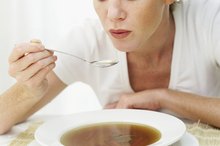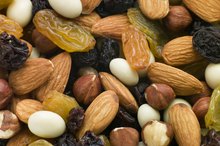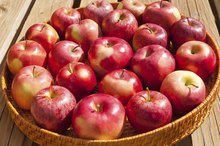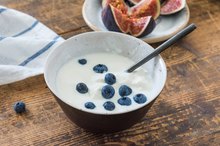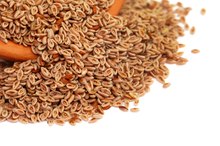The Best Foods to Help You Recover After Rectal Bleeding
Typically caused by hemorrhoids, an anal fissure, diverticulitis, irritable bowel disease, ulcers or colon cancer, rectal bleeding is first noticeable as red blood on your toilet paper or in the toilet bowl, normally after you have a bowel movement. If you notice this symptom, consult your physician. The safest foods for you to eat depend on the cause of your bleeding and should be directed by your doctor. However, in most cases of rectal bleeding, a diet high in fiber, up to 25 to 35 grams per day, with adequate fluids is recommended to support healthy bowel function and avoid further rectal bleeds 2.
Eat More Fruits and Vegetables
Among the best foods to stop bloody stool are nutrient-dense fruits and vegetables that include a variety of vitamins, minerals and fiber. As recommended by the American Heart Association, aim for four to five servings of each on a 2,000-calorie diet 3. Choose different colors and types of fruits and vegetables. Serving size examples include 1/2 cup of broccoli, potato or asparagus, 1 cup of fresh raspberries or one small apple. In fruits and vegetables, the fiber content varies, averaging between 0.5 and 4.8 grams per serving.
Read More: List of Foods High in Soluble Fiber
- Among the best foods to stop bloody stool are nutrient-dense fruits and vegetables.
- In fruits and vegetables, the fiber content varies, averaging between 0.5 and 4.8 grams per serving.
Hold the White Bread
Soft Diet List After Bowel Surgery
Learn More
Replacing white flour products with whole-grain sources is an easy way to add fiber as part of your rectal bleeding treatment diet. On a 2,000-calorie diet, aim for six to eight daily servings from the grain food group, with at least half being whole-grain sources. One-half cup of pasta, one slice of bread or 1 cup of shredded wheat cereal are good whole-grain choices. Read the ingredients on your food label to identify whole-grain sources, which have a higher fiber content per serving. The nutrition facts label will provide you with the specific amount of fiber per serving.
- Replacing white flour products with whole-grain sources is an easy way to add fiber as part of your rectal bleeding treatment diet.
- On a 2,000-calorie diet, aim for six to eight daily servings from the grain food group, with at least half being whole-grain sources.
Load Up on Legumes
Adequate fiber intake after a rectal bleed can also achieved by eating legumes. On a 2,000-calorie diet, the American Heart Association recommends a weekly intake of four to five servings of nuts, legumes and seeds 3. One-half cup of black, pinto or kidney beans, lentils, or chickpeas is considered a serving. Fiber content in legumes ranges from roughly 4 to 8 grams per serving.
- Adequate fiber intake after a rectal bleed can also achieved by eating legumes.
- One-half cup of black, pinto or kidney beans, lentils, or chickpeas is considered a serving.
Hydration Is Key
Do Some Foods Aggravate Diverticulitis?
Learn More
With the high-fiber diet, plenty of fluid intake is encouraged following a rectal bleed. Adequate water consumption will soften stools and prevent constipation. Calculate your daily water needs in ounces by taking your weight in pounds and dividing it in half; for example, if you weigh 150 pounds, you need about 75 ounces per day — about 9 cups 4. Fruit or vegetable juice and non-caffeinated beverages can also contribute to your daily fluid goals.
Read More: How Much Water to Drink per Day by Body Weight
- With the high-fiber diet, plenty of fluid intake is encouraged following a rectal bleed.
- Fruit or vegetable juice and non-caffeinated beverages can also contribute to your daily fluid goals.
Low Residue Diet
In certain situations, such as with inflammatory bowel disease like Crohn's or ulcerative colitis, your doctor may recommend a low residue diet for your rectal bleeding if the bleeding is due to a flare up in your condition 6. The diet is designed to reduce the frequency and volume of your stools to give your bowel a chance to rest and heal, according to UCSF Health. A low residue diet may also help to relieve abdominal pain and diarrhea 6. High-fiber foods are restricted on this diet 2. It excludes fresh fruits and vegetables but includes well-cooked or canned fruits and vegetables without seeds or skin. Examples are apple sauce, canned pears, asparagus tips, carrots, mushrooms, spinach, squash and cooked potatoes, lists WebMD 6. Legumes, seeds and nuts are omitted. In most cases, fats are allowed, especially omega-3 fatty acids found in fish. Small frequent meals are preferred.
Read More: What Foods Can You Eat If You Have Crohn's Disease or Colitis?
- In certain situations, such as with inflammatory bowel disease.
Related Articles
References
- Cleveland Clinic: Diseases and Conditions: Rectal Bleeding
- Colon and Rectal Surgery Associates: High-Fiber Diet
- American Heart Association: Suggested Servings From Each Food Group
- MyFoodDiary.com: Recommended Daily Water Intake
- University of California San Francisco: Nutrition Tips for Inflammatory Bowel Disease
- WebMD: Should You Try a Low-Residue Diet?
Writer Bio
Stacey Phillips is a registered dietitian and nutrition writer. She has had articles and patient information handouts published in the "Renal Nutrition Forum" and the "Journal of Renal Nutrition." She holds a Bachelor's degree from the University of Illinois in Champaign-Urbana and a Masters degree at Central Michigan University.
